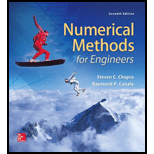
Concept explainers
Estimate the common logarithm of 10 using linear interpolation.
(a) Interpolate between
(b) Interpolate between
For each of the interpolations, compute the percent relative error based on the true value.
(a)
To calculate: The common logarithmic of
Answer to Problem 1P
Solution:
The common logarithmic of
Explanation of Solution
Given Information:
The values,
Formula used:
Linear interpolation formula:
And, formula for percentage relative error is,
Calculation:
Consider the values,
Here,
Thus, the value of log 10 by the linear interpolation is,
Now, the true value of
Hence, the value of log 10 by the linear interpolation is
(b)
To calculate: The common logarithmic of
Answer to Problem 1P
Solution:
The common logarithmic of
Explanation of Solution
Given Information:
The values,
Formula used:
Linear interpolation formula:
And, formula for percentage relative error is,
Calculation:
Consider the values,
Here,
Thus, the value of log 10 by the linear interpolation is,
Now, the true value of
Hence, the value of log 10 by the linear interpolation is
Want to see more full solutions like this?
Chapter 18 Solutions
Numerical Methods for Engineers
- Find the mean hourly cost when the cell phone described above is used for 240 minutes.arrow_forwardEnter the data from Table 2 into a graphing calculator and graph the ranking scatter plot. Determine whetherthe data from the table would likely represent a function that is linear, exponential, or logarithmic.arrow_forwardDoes a linear, exponential, or logarithmic model best fit the data in Table 2? Find the model.arrow_forward
- Algebra & Trigonometry with Analytic GeometryAlgebraISBN:9781133382119Author:SwokowskiPublisher:Cengage


 College Algebra (MindTap Course List)AlgebraISBN:9781305652231Author:R. David Gustafson, Jeff HughesPublisher:Cengage Learning
College Algebra (MindTap Course List)AlgebraISBN:9781305652231Author:R. David Gustafson, Jeff HughesPublisher:Cengage Learning Elementary Linear Algebra (MindTap Course List)AlgebraISBN:9781305658004Author:Ron LarsonPublisher:Cengage Learning
Elementary Linear Algebra (MindTap Course List)AlgebraISBN:9781305658004Author:Ron LarsonPublisher:Cengage Learning




